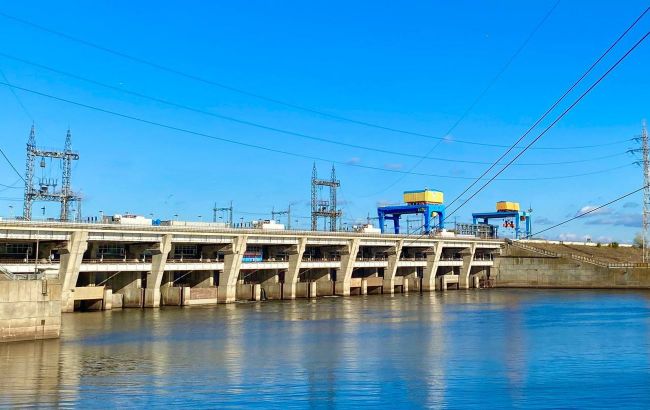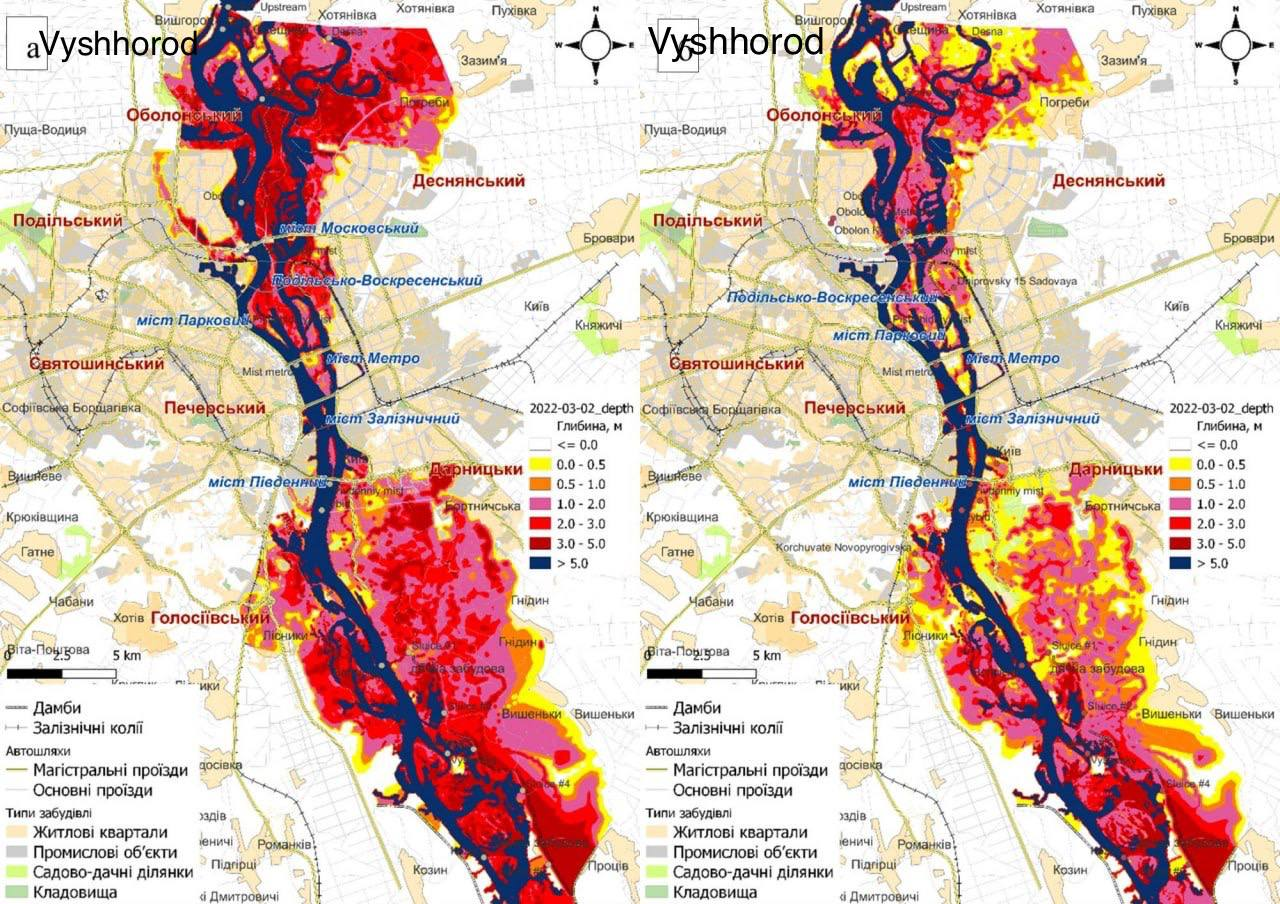Key facts about Kyiv Hydroelectric Power Plant and its strategic importance for Ukraine's energy system
 Photo: Kyiv Hydroelectric Power Plant (t.me/ukrhydroenergo)
Photo: Kyiv Hydroelectric Power Plant (t.me/ukrhydroenergo)
Amid the massive strike on Ukraine on August 26, Russian Telegram channels circulated a video allegedly showing an attack on the Kyiv Hydroelectric Power Plant (HPP). As of today, there are no official confirmations.
For more details on the facility and whether there's a risk of the dam being destroyed by rockets, read the article below.
Contents
- What is known about the Kyiv HPP
- Why the threat of dam breach is often discussed and whether there is a real danger
- Can a rocket strike destroy a dam
- What would happen to Kyiv in the event of a dam breach: Three scenarios
According to the Kyiv Regional Military Administration, two energy facilities were damaged today. It has not been specified whether the hydroelectric power plant in Vyshhorod is among them.
In response to media reports, Andrii Kovalenko, head of the National Security and Defense Council's Disinformation Countermeasures Center, stated that there is no threat to the Kyiv HPP's dam.
"It is impossible to destroy it with rockets. Comparing it to the situation in the Kherson region (the explosion of the Kakhovka reservoir dam by the Russian forces in June 2023) is not appropriate. There was an internal explosion there. The Russians are using this topic for informational purposes to incite panic, nothing more," he wrote on Telegram.
What is known about the Kyiv HPP
The Kyiv Hydro Power Plant (HPP) is the first (upper) stage of the Dnipro cascade of hydroelectric power plants. Located on the Dnipro River just a few kilometers from Kyiv, it was constructed in a record time from 1960 to 1968.
A notable feature of the Kyiv HPP is the use of horizontal capsule hydro units, which allowed for the design of a combined spillway-type building. The width of the HPP building is 51 meters, and its length is 285 meters.
The spillway section is integrated with the HPP building, which is structurally divided into five blocks, each housing four horizontal capsule units. As of September 2021, the installed capacity of the Kyiv HPP was 440 MW. This capacity is particularly crucial given the current generation deficit, where every megawatt counts.
The construction process included the implementation of new design solutions. Cost reduction and shortened construction times were achieved through the use of precast reinforced concrete. Additionally, new high-frequency installation technologies for large concrete structures were first introduced at the Kyiv HPP.
The HPP has 20 horizontal capsule units featuring adjustable-blade hydro turbines (PL 15/3251-GK-600M) and horizontal synchronous generators (SGK-538/160-70M UHL4).
Above the flow part of the HPP, in the turbine rooms, are the main generator terminals, oil-pressure units with aggregate speed regulators, pumps, and more. The upper covering of these rooms, along with the metal cover above the turbines, forms the spillway crest.
Since the late 1990s and throughout the 2000s, all hydro units have undergone reconstruction. According to the Ukrhydroenergo website, 16 units are connected to an automatic power and frequency regulation system managed from the NEC Ukrenergo dispatch center without the need for operational personnel intervention.
Why the threat of dam breach is often discussed and whether there is a real danger
Concerns about the Kyiv HPP typically arise in the context of potential strikes on the dam. In July, Ukrainian media, citing sources in the General Staff of the Armed Forces of Ukraine, reported that the military command views the threat as real. However, they believe that while Russian forces might attempt to damage critical elements of the structure, complete destruction is unlikely.
This concern is understandable, especially following the destruction of the Kakhovka HPP dam by the Russian army, which led to a major environmental and technological disaster last summer. The Kyiv HPP dam was first attacked by the enemy on February 26, 2022. Since then, official statements from the Air Force and monitoring channels have periodically reported missiles heading towards Vyshhorod.
In July, Russian Foreign Ministry spokesperson Maria Zakharova accused Ukraine of allegedly preparing a provocation, including the destruction of the Kyiv HPP dam. The Ukrainian side dismissed these accusations as absurd, with the Ministry of Foreign Affairs stating that "the Russian regime is perfectly capable of committing its own war crimes," and any actions against the dam would be solely Russia's responsibility.
The true aim of such statements by Russia is to intimidate Ukrainian society and mislead the international community and media. Russia has repeatedly used this strategy: accusing others of actions it is either currently undertaking or planning to undertake.
"The latest Russian fantasies about Dnipro dams are a reason for the international community to monitor Russia's actions even more closely," the Ukrainian Foreign Ministry added.
Given the strategic importance of the HPP, it is protected by departmental paramilitary guards in coordination with specialized units from other agencies.
Can a rocket strike destroy a dam
Even if the Russian Federation attempts to strike the Kyiv HPP dam, it is unlikely to be destroyed in the same manner as the Kakhovka HPP.
According to a statement from Ukrhydroenergo in the fall of 2022, the station and dam were designed and built during the Cold War with a significant margin of strength and resilience. Therefore, damaging them with a rocket strike is not straightforward.
"If the metal sluice gates of the dam are damaged, there may be a gradual uncontrolled leakage of water from the Kyiv Reservoir, which could cause temporary flooding of some areas downstream of the hydro system. The flooded zones would be minor and known to the State Emergency Service (SES) and local authorities, so residents," the statement noted.
In the summer, Ihor Syrota, General Director of Ukrhydroenergo, confirmed that the largest Ukrainian HPPs are nearly impossible to destroy from the outside. To achieve this, the enemy would have to enter Ukrainian territory with aircraft and drop several bombs.
"The Kyiv and Kaniv HPPs are located in the center of Ukraine, far from the front line, so enemy aviation is unlikely to come close. This is an extremely unlikely scenario. They were able to blow up the Kakhovka HPP from the inside because it was occupied by them," he said.
Moreover, even if the Kyiv HPP dam were destroyed, it would not lead to catastrophic consequences. At worst, it could result in "flooding of basements in some parts of Kyiv."
"In the event of significant damage from rockets, there could be a reservoir failure—people in nearby settlements would be left without water. However, there would be no catastrophic consequences like those in the Kherson region. Several rocket strikes in one location might create a breach in the dam through which water would flow. The Kakhovka HPP was almost completely destroyed, with 12 spillway gates damaged. This was a massive leak. Such an outcome cannot be achieved with rocket strikes alone," he explained.
What would happen to Kyiv in the event of a dam breach: Three scenarios
The potential consequences of a breach of the Kyiv HPP dam were analyzed by scientists from the Institute of Mathematical Machines and Systems of the National Academy of Sciences of Ukraine as early as April 2022. Detailed calculations are publicly available on the NAS website.
According to their analysis, the destruction of the dam poses a risk due to the sudden release of a large volume of water, the rapid spread of the wave across the Dnipro floodplain, and the flooding of Kyiv's banks. Three scenarios for potential outcomes have been developed for emergency response:
-
Unlikely scenario: A breach with a size of 400 meters and complete destruction of the HPP structures.
-
More likely scenario: Complete destruction of the dam with a breach size of 280 meters.
-
Also likely scenario: Partial destruction of the dam with a breach size of 100 meters.

Photo: likely consequences of the dam breach under the second and third scenarios (nas.gov.ua)
According to calculations, the largest areas of flooding are expected in regions with lower terrain. In the north—between the dam and the boundaries of Kyiv, in the Obolon and Troieschyna districts—with water levels rising by 3 meters or more. In the south—from the Southern Bridge to the protective dikes in Kozyn village and Protsiv village.
In the capital, small areas along Obolon Lakes may be flooded; islands (Trukhaniv, Dolobetsky, Venetsiansky), as well as dacha and cottage communities on the left bank (Rusanivski sady, Nyzhni sady, Desnyanske). Additionally, flooding threatens the area from the Dnipro River to the Capital Highway in the Holosiivskyi district, in Osokorky, and partially in Pozniaky and Bortnychi near the Vitovets and Zaplavne lakes.
Scientists emphasize that even with the complete destruction of the dam, there will be time for the evacuation of Kyiv residents or for moving them to higher floors in high-rise buildings. Therefore, an apocalyptic tsunami scenario for entire districts of the capital is not expected.
Sources: statements from Andrii Kovalenko, head of the National Security and Defense Council's Disinformation Countermeasures Center; information from the Ukrhydroenergo website; an interview with the CEO of the company, Ihor Syrota, for Forbes; and calculations from the National Academy of Sciences of Ukraine.

